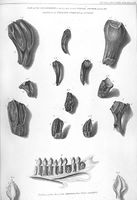Art by Henry Boltinoff, Showcase #41< DC Comics, 1962
Plus some Science Facts from Showcase #40:

 He searched on the banks of the Solo River, with two assigned engineers and a crew of convict labourers to help him. In September 1890, his workers found a human, or human-like, fossil at Koedoeng Broeboes. This consisted of the right side of the chin of a lower jaw and three attached teeth. In August 1891 he found a primate molar tooth.
He searched on the banks of the Solo River, with two assigned engineers and a crew of convict labourers to help him. In September 1890, his workers found a human, or human-like, fossil at Koedoeng Broeboes. This consisted of the right side of the chin of a lower jaw and three attached teeth. In August 1891 he found a primate molar tooth. meter away was found an intact skullcap, the fossil which would be known as Java Man. In August 1892, a third primate fossil, an almost complete left thigh bone, was found between 10 and 15 meters away from the skullcap.
meter away was found an intact skullcap, the fossil which would be known as Java Man. In August 1892, a third primate fossil, an almost complete left thigh bone, was found between 10 and 15 meters away from the skullcap.

 complex structures, once lost, are not regained in their original form. (While generally true, some exceptions are known.)
complex structures, once lost, are not regained in their original form. (While generally true, some exceptions are known.) Professor Emeritus in the Department of Earth Sciences, University of Alberta, passed away on Thursday, November 29.
Professor Emeritus in the Department of Earth Sciences, University of Alberta, passed away on Thursday, November 29.  mathematical theory of natural selection. It treated many major cases for the first time, showing the direction and rates of changes of gene frequencies. It also pioneered in investigating the interaction of natural selection with mutation and with migration.
mathematical theory of natural selection. It treated many major cases for the first time, showing the direction and rates of changes of gene frequencies. It also pioneered in investigating the interaction of natural selection with mutation and with migration. some of the most important principles of modern geology. He was Danish royal anatomist for 2 years.
some of the most important principles of modern geology. He was Danish royal anatomist for 2 years. The film featured Leopold Stokowski and the Philadelphia Orchestra performing a number of pieces of classical music to the film’s animated visuals. Igor Stravinsky’s “Rite of Spring” provided the score for the evolution of the Earth including a wonderful sequence on the extinction of the dinosaurs at the end of the Cretaceous. Many school teachers actually showed this sequence in science class up through the 1970's as it was one of the most accurate animated depictions to that date.
The film featured Leopold Stokowski and the Philadelphia Orchestra performing a number of pieces of classical music to the film’s animated visuals. Igor Stravinsky’s “Rite of Spring” provided the score for the evolution of the Earth including a wonderful sequence on the extinction of the dinosaurs at the end of the Cretaceous. Many school teachers actually showed this sequence in science class up through the 1970's as it was one of the most accurate animated depictions to that date.
 and he had discovered bones belonging to three extinct species: a giant crocodile, a plesiosaur, and Buckland's Megalosaurus. But in 1822 he found several teeth that "possessed characters so remarkable" that they had to have come from a fourth and distinct species of Saurian. After consulting numerous experts, Mantell finally recognized that the teeth bore an uncanny resemblance to the teeth of the living iguana, except that they were twenty times larger.
and he had discovered bones belonging to three extinct species: a giant crocodile, a plesiosaur, and Buckland's Megalosaurus. But in 1822 he found several teeth that "possessed characters so remarkable" that they had to have come from a fourth and distinct species of Saurian. After consulting numerous experts, Mantell finally recognized that the teeth bore an uncanny resemblance to the teeth of the living iguana, except that they were twenty times larger. 


 who proposed what came to be called the Ordovician period (505 to 438 million years old) of geologic strata. Lapworth is famous for his work with marine fossils called graptolites.
who proposed what came to be called the Ordovician period (505 to 438 million years old) of geologic strata. Lapworth is famous for his work with marine fossils called graptolites.The Palaeoblog occasionally gets sent books to review which we get around to doing eventually. This one, dealing with the origins of the first Americans, falls more under archaeology than palaeontology, so I've asked the Cleveland Museum of Natural History's John Otis Hower Chair of Archaeology, Dr. Brian Redmond, to review this for us. Thanks Brian!Who were the first Americans? When did they come to the New World and by what routes? These questions have maintained a featured place in archaeological inquiry since the era of Thomas Jefferson, the recognized father of American Archaeology. This much-awaited book by two leading Paleoindian scholars argues for an origin, not from northeastern Asia as conventionally proposed, but across the north Atlantic from Iberia during the late glacial maximum, some 20,000 years ago. Using detailed, but not overly technical, presentations of late Pleistocene stone tool assemblages from Siberia to Chesapeake Bay, the authors state their case for the origin of the classic Clovis tool kit in eastern North America from Upper Paleolithic, Solutrean, migrants from Europe. Bradley uses his substantial experience as a stone tool analyst and flint-knapper to point out the intriguing similarities between bifacially-flaked spear and knife points found on both sides of the Atlantic. But most previous scholars have judged such a connection untenable due to the three to twelve thousand years that separated Solutrean from Clovis hunters. To fill the gap, Stanford and Bradley cite a growing body of archaeological evidence for a “pre-Clovis” occupation of eastern North America as early as 25,000 years ago. This overview of the evidence is highly informative, well-illustrated, and brings to print the newest data for Clovis progenitors in the mid-Atlantic region. The authors even make a good case that Solutrean seal hunters from Europe could have migrated north and west along the north Atlantic ice front and ended up in North America. Much less convincing is their claim for real historical affinity between Solutrean, pre-Clovis, and Clovis. In the end, the still sketchy pre-Clovis data base severely weakens the argument. But the book remains a fascinating and informative read for all students of the earliest American history.
